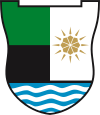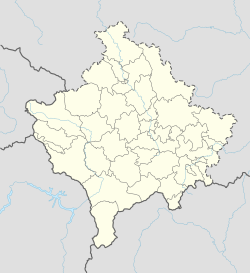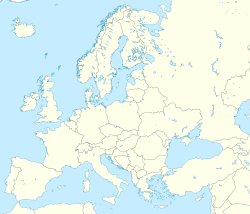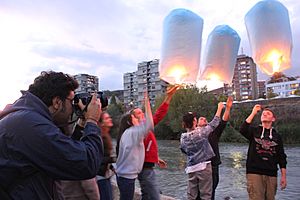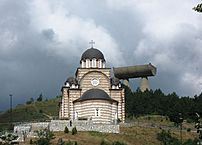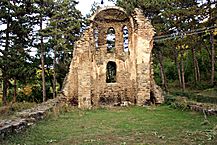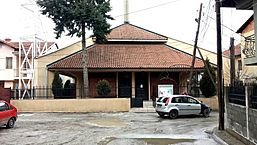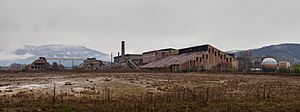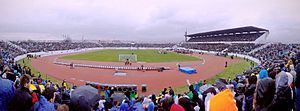Mitrovica, Kosovo facts for kids
Quick facts for kids
Mitrovica
South Mitrovica
|
||
|---|---|---|
|
City and municipality
|
||
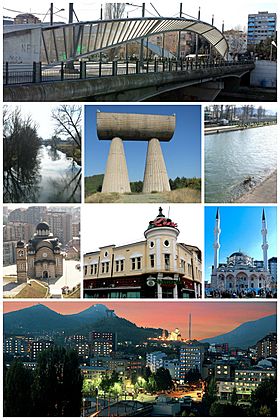
Ibar Bridge, Sitnica River, Miners Monument, Ibar River, St. Dimitri Orthodox Church, Former Jadran Hotel, Sand's Mosque, Mitrovica at night panoramic view.
|
||
|
||
| Country | Kosovo | |
| Area | ||
| • Municipality | 331 km2 (128 sq mi) | |
| • Urban | 54.983 km2 (21.229 sq mi) | |
| Area rank | 17th in Kosovo | |
| Elevation | 500 m (1,600 ft) | |
| Population
(2024)
|
||
| • Municipality | 68,000 | |
| • Density | 205.4/km2 (532/sq mi) | |
| Demonym(s) | Albanian: Mitrovicas (m), Mitrovicase (f) Gheg dialect: Mitrovicali (m) Mitrovicalike (f) |
|
| Time zone | UTC+1 (CET) | |
| • Summer (DST) | UTC+2 (CEST) | |
| Postal code |
40000
|
|
| Area code(s) | +383 28 | |
| Vehicle registration | 02 | |
Mitrovica is a city in northern Kosovo. It is an important center for the District of Mitrovica. The city is sometimes called South Mitrovica. In 2013, Mitrovica was split into two parts: South Mitrovica and North Mitrovica.
The city sits about 10 kilometers (6 miles) from Gazivoda Lake. It is located where the Ibër, Sitnicë, Lushta, and Trepça rivers meet. Mountains like Kopaonik, Rogozna, Mokna, and Çyçavica surround the city. In 2011, the two parts of Mitrovica had about 97,686 people living there.
Mitrovica has a very long history, going back to ancient times. People lived here during the Neolithic (New Stone Age) and Roman periods. In the Middle Ages, the area was important for the Byzantine Empire and Serbian Empire. The modern city started during the rule of the Ottoman Empire in the 17th century. Its location on trade routes made it a key place for business and cultural exchange.
In more recent times, Mitrovica became known for its Trepča Mines. These mines were very important during the Yugoslav period. After the Kosovo War in 1999, the city became divided. The Ibar River now separates South Mitrovica (mostly Albanian) from North Mitrovica (mostly Serb).
Mitrovica is rich in minerals like lead and zinc. It used to be a big industrial city because of the Trepça Mines. However, after the 1999 war and the city's division, its economy struggled. Today, it is one of the poorer regions in Kosovo.
The city is also a university center. It has the University of Mitrovica "Isa Boletini" in the south. There are also parts of the University of Pristina in the north. Mitrovica is known for its music, including the Mitrovica Rock School. It hosts many cultural events and festivals. The city has a museum, a library, a theater, and many sports clubs.
Some important historical places nearby include the 13th-century St. Peter's Catholic Church. There are also the 14th-century monasteries of Banjska and Sokolica. The Ibar Bridge has become a symbol of the city's division.
Contents
What's in a Name?
The name Mitrovica comes from "Demetrius." It was likely named after an 8th-century Byzantine church. This church, called St. Demetrius, was built near Zvečan Fortress.
The city's name first appeared in 1430 as 'Dimitrovica' in a Roman document. Later, in 1446, it was called 'De Dimitruic'. Travelers in the Ottoman era used names like 'Mitrix' (1499) and 'Bazar Mitrovica' (1530). The name 'Mitrovica' was first written in 1660 by the explorer Evliya Çelebi.
From 1878 to 1890, it was known as 'Mitrovica of Bazar'. This was probably because it was part of the Sanjak of Novi Pazar.
After President Tito died in 1980, many places in Yugoslavia were named after him. So, Mitrovica was called Titova Mitrovica until 1991.
Today, the official names are Mitrovicë or Mitrovica in Albanian, and Mitrovica in Serbian. In Serbian, it's sometimes called Kosovska Mitrovica to tell it apart from another city, Sremska Mitrovica.
Since 2013, the city is officially divided. The southern part is South Mitrovica. The northern part is North Mitrovica.
A Look at History
Ancient Times: Neolithic Period
There is proof that people have lived in the Mitrovica region since the Neolithic era. This is the New Stone Age. The oldest settlements found are Zhitkoc, Karagaç, and Vallaç. These are near Zvecan, just north of Mitrovica. Another site, Fafos, is in the city's suburbs.
At Zhitkoc, near the Ibër River, old settlements from the Starčevo culture and Vinča culture were found. At Karagaç, archaeologists found remains of huts from the middle Neolithic period. These huts were protected by ditches.
The Fafos site is in Mitrovica's industrial area. Here, two separate Vinča culture settlements were found. Many huts at these sites were destroyed by fire. Objects like ritual vases and human-like figures were discovered. These findings show that people lived here continuously from prehistoric times.
Middle Ages: Fortresses and Monasteries
Not much is known about the early Middle Ages in this region. But between the 9th and 15th centuries, the area was a key spot for conflicts. The Byzantine Empire, Medieval Serbia, Bulgarian Empire, and Ottoman Empire all ruled here at different times.
The fortified town of Zvečan became very important. It played a big role in the growth of the Kingdom of Serbia. Its strong location made it a center of power.
At the same time, Trepca grew into a busy mining town. Mining and trade helped the region's economy grow a lot.
Important buildings from this time include the Banjska Monastery and Sokolica Monastery. Also, the Saxon St. Peter's Basilica Church was built by Saxons. This shows how important the mining industry was.
After the Battle of Kosovo in 1389, the Ottomans took over. Zvecan Fortress became a military site until the 18th century. Then, people moved to the valleys of the Ibar and Sitnica rivers. This is how the modern city of Mitrovica began.
Ottoman Empire: Growth and Trade
Under Ottoman rule, Mitrovica was a small city. It grew quickly in the 19th century when lead ore was found and mined. This became one of Kosovo's biggest industries.
Mitrovica became an industrial town and a center for trade. This happened after the railway line to Skopje was finished in 1873–1878. This railway connected Mitrovica to the port of Thessaloniki. Another line later linked the town to Belgrade and Western Europe.
Modern History: Division and Challenges
During World War II, the city was part of Axis-occupied Serbia. By the early 1990s, Mitrovica had about 75,000 people.
Kosovo War and City Division
The 1999 Kosovo War greatly affected Mitrovica. Before the war, the Kosovo Liberation Army (KLA) was active here. After the war, NATO troops from France, the United Arab Emirates, and Denmark were stationed in Mitrovica.
Many Roma fled to Serbia or moved to camps in North Mitrovica. Most Serbs living on the south side moved to North Mitrovica after the war. In 2011, the city had about 71,601 people.
Mitrovica became a place for ethnic clashes between different groups. The bridges connecting the two sides were guarded. KFOR troops and United Nations Interim Administration Mission in Kosovo (UNMIK) police were there to keep peace. However, violence still happened, leading to checkpoints and guards.
On March 17, 2004, three Albanian children drowned in the river. This led to major ethnic violence in the city. A Serbian teenager was also killed. Riots and gunfire broke out, leaving many dead and injured. This was the worst unrest in Kosovo since the 1999 war.
Kosovo's Independence
Tensions increased in Mitrovica after Kosovo declared independence in 2008. Some Serb police officers refused to follow orders from Albanian authorities. Serb protesters also stopped Albanian court employees from crossing the Ibar River bridge.
In 2013, the Brussels Agreement was signed. Under this agreement, Kosovo Serbs accepted the police and courts run by Pristina. Elected Serbs now swear loyalty to the Republic of Kosovo.
Since 2012, the New Bridge over the Ibar River is patrolled 24/7 by Italian Carabinieri from KFOR.
People of Mitrovica
Population Changes
In 2011, the city of Mitrovica had 84,235 people. Most lived in the southern part (71,909 people). About 12,326 lived in North Mitrovica.
The Kosovo war and economic problems caused many people to leave Mitrovica. In 1948, the city had 32,800 people. By 1991, it grew to 104,885. But in 2011, the population dropped to 84,235.
In 2015, about 100,000 people left Kosovo for Western Europe. During this time, 4,889 people left South Mitrovica. By the end of 2015, about 80,623 people lived in the city of Mitrovica.
Different Groups of People
Mitrovica has many different ethnic groups. The largest group is Albanians. Other groups include Serbs, Bosniaks, Turks, and Roma.
In South Mitrovica, Albanians make up about 96.65% of the population. Other groups like Roma, Turks, and Bosniaks also live there. According to the 2011 census, only 14 Serbs lived in South Mitrovica.
| Group | Population | Percentage |
|---|---|---|
| Albanians | 69,497 | 96.65% |
| Serbs | 14 | 0.02% |
| Turks | 518 | 0.72% |
| Bosniaks | 416 | 0.58% |
| Roma | 528 | 0.73% |
| Ashkali | 647 | 0.9% |
| Egyptians | 6 | 0.01% |
| Gorani | 23 | 0.03% |
| Other (specify) | 47 | 0.07% |
| Prefer not to answer | 61 | 0.08% |
| Not available | 152 | 0.21% |
| Total | 71,909 | 100% |
Religions in Mitrovica
The main religion in Mitrovica is Muslim. There are also smaller groups of Serbian Orthodox and Roman Catholics. Most Albanians, Bosniaks, Turks, and Roma are Muslim.
In 2011, about 99.32% of people in South Mitrovica were Muslim. Orthodox Christians made up 0.02%, and Catholics 0.06%. There is no official data for North Mitrovica.
City Life and Economy
Economy and Jobs
The Trepça Mines are in Mitrovica. They were once among Europe's largest mines. However, after the war, most of their operations closed.
Because of political problems and the city's division, many people in Mitrovica do not have jobs. The unemployment rate is about 65%. The local government and public companies help the economy. The Serbian government and EU donations also provide support.
Education for Young People
In South Mitrovica, there are 31 primary and lower secondary schools. These schools use 42 different buildings. There are also 5 upper secondary schools. The city has one large kindergarten that can hold 300 children.
For higher education, there is the Public University of Mitrovica "Isa Boletini". There is also the University of Applied Sciences.
In North Mitrovica, there are 11 primary schools, four secondary schools, and one kindergarten. The University of Pristina is also there. This university moved from Pristina to North Mitrovica after the Kosovo War.
There are also two private universities in South Mitrovica. One is College "Fama" and the other is International Business College Mitrovica (IBCM). IBCM has campuses in both parts of the city.
Culture and Fun
The City Museum of Mitrovica is located here. Mitrovica is known for its music scene. It hosts many cultural events. These include Green Fest, Mitrovica Jazz Days Festival, and Mitrovica Guitar Days.
Places to See
The Mitrovica region is located between two big rivers, Ibar and Sitnica. It also has rich minerals. This made it a popular place for people to live since ancient times. The Illyrians, especially the Dardan tribe, lived here.
Archaeologists have found many old objects and traces of settlements. These include items from the neolithic, Roman, and medieval periods. They have found fortress remains, burial sites, statues, and jewelry.
Sports in Mitrovica
Mitrovica is home to several sports clubs. The most famous ones represent Trepça. KF Trepça and KF Trepça'89 are football clubs. They play in the Football Superleague of Kosovo and have won many titles.
KF Trepça plays at the Adem Jashari Olympic Stadium. This stadium hosted Kosovo's first international football match in 2014. Other football clubs include KF Mitrovica and KF Bardhi. The women's football club, KFF Mitrovica, is very successful.
Basketball is also popular, with KB Trepça being one of the top clubs in Kosovo. Handball is represented by KH Trepça.
Famous People from Mitrovica
- Ali Shukrija, former leader of Kosovo
- Kadri Veseli, former Speaker of the Assembly of Kosovo
- Isa Boletini, Albanian patriot
- Bajram Rexhepi, former Prime Minister of Kosovo
- Valon Behrami, Swiss international football player
- Stefan Dečanski, King of Serbia
- Nevena Božović, Serbian singer
- Miloš Krasić, former Serbian football player
- Riza Lushta, former Albanian football player
- Vjosa Osmani, current President of Kosovo
- Rona Nishliu, singer who represented Albania at Eurovision
- Valdet Rama, Albanian footballer
- MC Kresha, Albanian rapper
- Goran Rakić, politician
Sister Cities
Mitrovica has "sister city" relationships with other cities around the world. This means they share cultural ties and friendly connections.
 İnegöl, Turkey
İnegöl, Turkey Kendari, Indonesia
Kendari, Indonesia Korçë, Albania
Korçë, Albania
See also
 In Spanish: Mitrovica (Kosovo) para niños
In Spanish: Mitrovica (Kosovo) para niños


